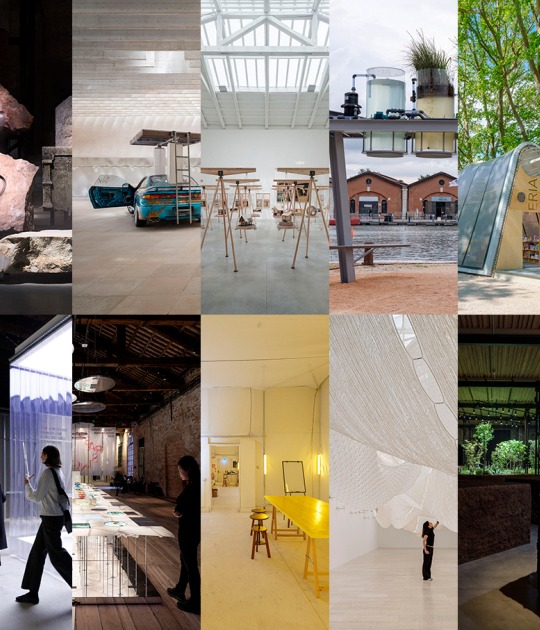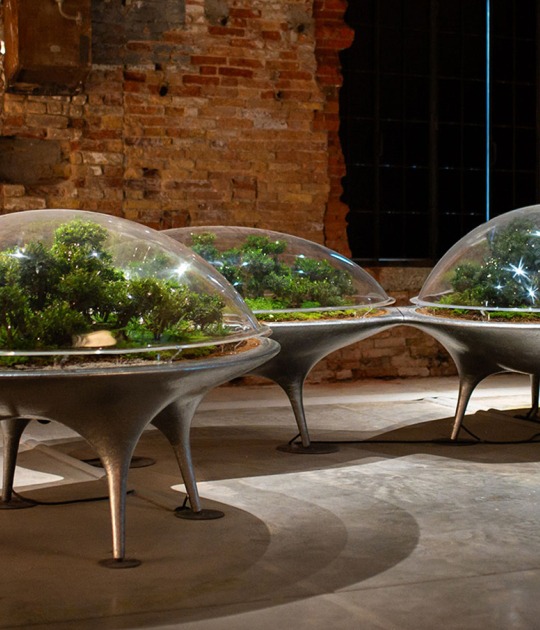Our curatorial proposal is based on thinking of Brazil as Terra/Earth. Earth as soil, fertiliser, ground and territory. But also the earth in its global and cosmic sense, as a planet and the common house of all life, human and non-human.
Earth as memory, and also as future, looking at the past and at heritage to expand the field of architecture in the face of the most pressing contemporary urban, territorial and environmental issues"
Earth as memory, and also as future, looking at the past and at heritage to expand the field of architecture in the face of the most pressing contemporary urban, territorial and environmental issues"
Gabriela de Matos and Paulo Tavares

Brazil pavilion, Terra [Earth]. Photograph by Matteo de Mayda. Courtesy of La Biennale di Venezia.
The exhibition demonstrates what several scientific studies prove: that Indigenous and Quilombola lands are the best-preserved territories in Brazil, and in that waypoint towards a post-climate change future that “decolonization” and “decarbonization” walk hand in hand. Their practices, technologies, and customs linked to land management and production, like other ways of doing and understanding architecture, are located on the earth, are equally universal, and carry within themselves the ancestral knowledge to re-signify the present and design other planetary futures, for both human and nonhuman communities alike.
The first gallery of the modernist pavilion has been named "De-colonizing the Canon" by the curators, questioning the imaginary surrounding the version that Brasília, the capital of Brazil, was built in the middle of nowhere, given that its Indigenous and Quilombola inhabitants had been removed from the region in the colonial period, and were finally pushed to the fringes with the imposition of the modern city.

Brazil pavilion, Terra [Earth]. Photograph by Rafa Jacinto. Courtesy Fundação Bienal de São Paulo.

Brazil pavilion, Terra [Earth]. Photograph by Matteo de Mayda. Courtesy of La Biennale di Venezia.

Juliana Vicente, Terra Nakupa, 2023, video.
The second gallery, named Places of Origin, Archaeologies of the Future, welcomes us with the screening of the two supports video installation by Ayrson Heráclito – The Shaking of the Casa da Torre and of the Maison des Esclaves in Gorée, from 2015 – and turns to memories and the archaeology of ancestrality. Occupied by socio-spatial projects and practices of Indigenous and Afro-Brazilian knowledge about land and territory, the curatorship brings forth five essential memorial heritages of reference.
METALOCUS is live reporting from the Venice Architecture Biennale, which takes place from 20 May to 26 November 2023. See METALOCUS Guide LA BIENNALE DI VENEZIA for all the latest information you need to know to attend and know the best events and pavilions in LA BIENNALE.

![Brazil pavilion, Terra [Earth]. Photograph by Matteo de Mayda. Courtesy of La Biennale di Venezia. Brazil pavilion, Terra [Earth]. Photograph by Matteo de Mayda. Courtesy of La Biennale di Venezia.](/sites/default/files/styles/mopis_news_carousel_item_desktop/public/metalocus_brazil-pavilion-earth_venice-architecture-biennale-2023_11.jpg?itok=EFnP5EBG)
![Brazil pavilion, Terra [Earth]. Photograph by Rafa Jacinto. Courtesy Fundação Bienal de São Paulo Brazil pavilion, Terra [Earth]. Photograph by Rafa Jacinto. Courtesy Fundação Bienal de São Paulo](/sites/default/files/styles/mopis_news_gallery_first_deskop/public/metalocus_brazil-pavilion-earth_venice-architecture-biennale-2023_13.jpg?itok=kQr6Mfu1)
![Brazil pavilion, Terra [Earth]. Photograph by Rafa Jacinto. Courtesy Fundação Bienal de São Paulo Brazil pavilion, Terra [Earth]. Photograph by Rafa Jacinto. Courtesy Fundação Bienal de São Paulo](/sites/default/files/styles/mopis_news_carousel_item_desktop/public/metalocus_brazil-pavilion-earth_venice-architecture-biennale-2023_14.jpg?itok=6Um26Bir)
![Brazil pavilion, Terra [Earth]. Photograph by Rafa Jacinto. Courtesy Fundação Bienal de São Paulo Brazil pavilion, Terra [Earth]. Photograph by Rafa Jacinto. Courtesy Fundação Bienal de São Paulo](/sites/default/files/styles/mopis_news_carousel_item_desktop/public/metalocus_brazil-pavilion-earth_venice-architecture-biennale-2023_12.jpg?itok=efDpWhE3)
![Brazil pavilion, Terra [Earth]. Photograph by Rafa Jacinto. Courtesy Fundação Bienal de São Paulo Brazil pavilion, Terra [Earth]. Photograph by Rafa Jacinto. Courtesy Fundação Bienal de São Paulo](/sites/default/files/styles/mopis_news_carousel_item_desktop/public/metalocus_brazil-pavilion-earth_venice-architecture-biennale-2023_15.jpg?itok=pxYOzGFS)
![Brazil pavilion, Terra [Earth]. Photograph by Matteo de Mayda. Courtesy of La Biennale di Venezia. Brazil pavilion, Terra [Earth]. Photograph by Matteo de Mayda. Courtesy of La Biennale di Venezia.](/sites/default/files/styles/mopis_news_carousel_item_desktop/public/metalocus_brazil-pavilion-earth_venice-architecture-biennale-2023_18a.jpg?itok=e5dlnIYU)
![Brazil pavilion, Terra [Earth]. Photograph by Matteo de Mayda. Courtesy of La Biennale di Venezia. Brazil pavilion, Terra [Earth]. Photograph by Matteo de Mayda. Courtesy of La Biennale di Venezia.](/sites/default/files/styles/mopis_news_carousel_item_desktop/public/metalocus_brazil-pavilion-earth_venice-architecture-biennale-2023_17a.jpg?itok=gUmggxn7)
![Brazil pavilion, Terra [Earth]. Photograph by Matteo de Mayda. Courtesy of La Biennale di Venezia. Brazil pavilion, Terra [Earth]. Photograph by Matteo de Mayda. Courtesy of La Biennale di Venezia.](/sites/default/files/styles/mopis_news_carousel_item_desktop/public/metalocus_brazil-pavilion-earth_venice-architecture-biennale-2023_15a.jpg?itok=lvBUwK-3)
![Brazil pavilion, Terra [Earth]. Photograph by Matteo de Mayda. Courtesy of La Biennale di Venezia. Brazil pavilion, Terra [Earth]. Photograph by Matteo de Mayda. Courtesy of La Biennale di Venezia.](/sites/default/files/styles/mopis_news_carousel_item_desktop/public/metalocus_brazil-pavilion-earth_venice-architecture-biennale-2023_14a.jpg?itok=L_Sb63ts)
![Brazil pavilion, Terra [Earth]. Photograph by Matteo de Mayda. Courtesy of La Biennale di Venezia. Brazil pavilion, Terra [Earth]. Photograph by Matteo de Mayda. Courtesy of La Biennale di Venezia.](/sites/default/files/styles/mopis_news_carousel_item_desktop/public/metalocus_brazil-pavilion-earth_venice-architecture-biennale-2023_16a.jpg?itok=Xgbb1Y6h)
![Brazil pavilion, Terra [Earth]. Photograph by Matteo de Mayda. Courtesy of La Biennale di Venezia. Brazil pavilion, Terra [Earth]. Photograph by Matteo de Mayda. Courtesy of La Biennale di Venezia.](/sites/default/files/styles/mopis_news_carousel_item_desktop/public/metalocus_brazil-pavilion-earth_venice-architecture-biennale-2023_20.jpg?itok=o9bUWPFO)
![Brazil pavilion, Terra [Earth]. Photograph by Matteo de Mayda. Courtesy of La Biennale di Venezia. Brazil pavilion, Terra [Earth]. Photograph by Matteo de Mayda. Courtesy of La Biennale di Venezia.](/sites/default/files/styles/mopis_news_carousel_item_desktop/public/metalocus_brazil-pavilion-earth_venice-architecture-biennale-2023_04.jpg?itok=72m5uRlw)
![Brazil pavilion, Terra [Earth]. Photograph by Rafa Jacinto. Courtesy Fundação Bienal de São Paulo Brazil pavilion, Terra [Earth]. Photograph by Rafa Jacinto. Courtesy Fundação Bienal de São Paulo](/sites/default/files/styles/mopis_news_carousel_item_desktop/public/metalocus_brazil-pavilion-earth_venice-architecture-biennale-2023_05.jpg?itok=B_BJTZxb)
![Rafa Jacinto. Courtesy Fundação Bienal de São Paulo Brazil pavilion, Terra [Earth]. Photograph by Rafa Jacinto. Courtesy Fundação Bienal de São Paulo](/sites/default/files/styles/mopis_news_carousel_item_desktop/public/metalocus_brazil-pavilion-earth_venice-architecture-biennale-2023_06.jpg?itok=TgkV9ubY)
![Brazil pavilion, Terra [Earth]. Photograph by Rafa Jacinto. Courtesy Fundação Bienal de São Paulo Brazil pavilion, Terra [Earth]. Photograph by Rafa Jacinto. Courtesy Fundação Bienal de São Paulo](/sites/default/files/styles/mopis_news_carousel_item_desktop/public/metalocus_brazil-pavilion-earth_venice-architecture-biennale-2023_07.jpg?itok=lnkAgs9i)
![Curators. Brazil pavilion, Terra [Earth]. Photograph by Matteo de Mayda. Courtesy of La Biennale di Venezia. Curators. Brazil pavilion, Terra [Earth]. Photograph by Matteo de Mayda. Courtesy of La Biennale di Venezia.](/sites/default/files/styles/mopis_news_carousel_item_desktop/public/metalocus_brazil-pavilion-earth_venice-architecture-biennale-2023_21.jpg?itok=53R4L7Kn)

























